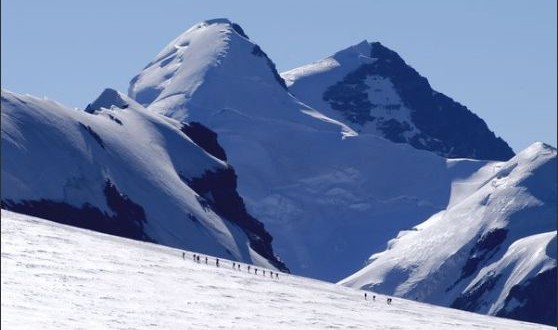The Pollux or in Italian Punta Polluce is one of the two peaks known as the Twins. With a height of 4092 meters, it is lower than its twin brother Castor. Both mountains lie between the Breithorn massif and the Liskamm, with Pollux lying to the north-west of Castor. They are separated by the Zwillingsjoch. The ascent involves a glacier crossing and rock climbing.
Pollux is named after one of the Greek twins Kastor and Polydeuces, son of Zeus. The Latin names Castor and Pollux are used here. There is a Greek legend to this mountain. Polydeuces was the son of Leda and Zeus, who appeared to her in the form of a swan. The Ancient Greeks disagreed about Castor’s origin, however. For some, he was the son of Leda and her husband Tyndareos, was conceived in the same night as Polydeuces. As they were conceived in the same night, they were twins and inseparable, although, as the son of Zeus, Polydeuces was a half-god, while Castor was a mortal. Others believed that, like his brother, Castor was also a son of Zeus. Both of them took part in the voyage of Jason and the Argonauts in the search for the Golden Fleece, and they also accompanied Hercles on his journey to the Amazons. The end of the Dioscouroi was initiated by a quarrel started by Castor with his cousin Idas. Idas slew Castor, after which Polydeuces killed Idas’s brother Lynceus. Zeus then intervened by destroying Idas with a bolt of lightning. Being immortal due to his paternity, Polydeuces thereafter mourned his brother, and asked his father to take away his immortality so that he could join his brother in the Land of the Dead. Moved by so much love, Zeus allowed his son to choose to either remain forever young and to live among the Gods, or to stay with Castor alternately one day in the underworld of Hades and one day in Olympus with the Gods, and to thereby become older, and to finally die. Without any hesitation, Polydeuces chose the latter and, from then on, traveled between Olympus and Hades with his brother. Often, however, they are both described as sons of Zeus, both immortal and together with their sister Helen, also a daughter of Zeus, born from a single egg or as a pair of brothers from a second egg. They were considered the pride of Sparta.
The Pollux was first ascended by Jules Jacot, Josef-Marie Perren and Peter Taugwalder senior on August 1st 1864. To get to the Pollux, from Zermatt, take the cableway to Klein Matterhorn. From there it takes approximately two hours of nice walking on the glacier in south-east direction before the 90 minutes climb begin with a 50 degree snow slope to the top. It can also be reached from the Monte Rosa hut using the same route as Castor, except one either goes up the rock wall to the top, or move over to the north ridge and up the firm to the top.

